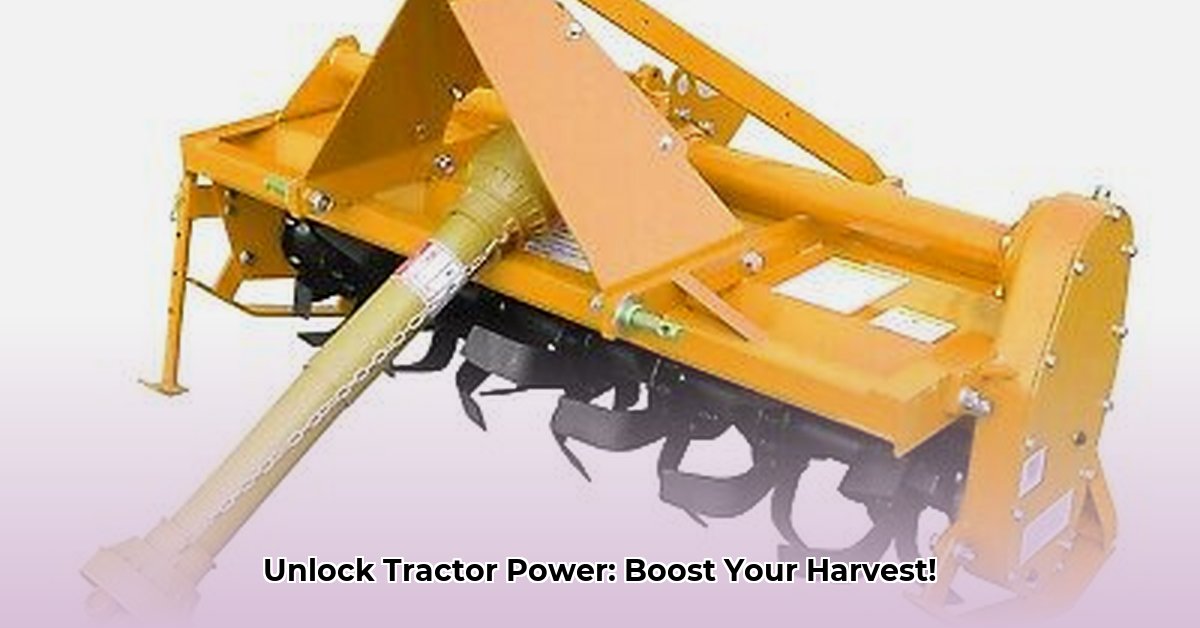
Choosing the right rototiller attachment for your tractor is a crucial decision impacting your farm's efficiency and yields. This guide will help you select, use, and maintain your rototiller, maximizing its lifespan and minimizing environmental impact. We'll explore various types, offer a step-by-step selection process, and highlight sustainable practices. For more in-depth information, check out this helpful resource on tractor rototillers.
Understanding Your Needs: Pre-Purchase Considerations
Before selecting a rototiller, assess your farming operation. Consider the size of your land, soil type (clay, sandy, loam), and crops you grow. These factors directly influence the type and size of rototiller needed. A small garden demands a compact model, while expansive fields require a larger, more powerful one. What's your budget? Heavy-duty models cost more but offer increased longevity. Are you prioritizing fuel efficiency and sustainable practices? This will impact material and design choices. A small tractor needs a correspondingly smaller tiller to avoid overloading.
Types of Tractor Rototillers: A Comparative Overview
Several rototiller types cater to diverse needs:
Standard Rototillers: These versatile tillers are ideal for general soil preparation. They offer a balance of price and performance, making them a popular choice for many farms.
Heavy-Duty Rototillers: Built for challenging conditions like rocky or compacted soil, these robust tillers are more expensive but exceptionally durable. They're a worthwhile investment for long-term use in demanding environments.
Precision Rototillers: Offering finer control over tilling depth and width, these tillers minimize soil disruption, promoting sustainable farming practices and creating a more even seedbed for planting.
Selecting the Right Rototiller: A Step-by-Step Guide
Choosing the best rototiller involves careful consideration of several key factors:
Power Matching: Ensure the tiller's horsepower requirements align with your tractor's PTO (Power Take-Off) capacity. Mismatched power can lead to damage or inefficient operation.
Tine Selection: Consider the number and design of tines (rotating blades). More tines generally provide finer tilling but demand more power. The material (hardened steel is more durable) also impacts longevity and performance.
Width Optimization: Choose a tiller width that suits your field size and tractor maneuverability. A width that's too large will hinder turning, while a narrow width increases tilling time.
Depth Control: Adjustable depth control is crucial for customizing tilling based on soil conditions and planting requirements. A wider adjustment range offers greater flexibility.
Safety Features: Prioritize safety features such as slip clutches. These mechanisms protect your tractor, the tiller, and you from damage caused by striking rocks or obstructions.
Maintaining Your Rototiller: Extending Lifespan and Efficiency
Regular maintenance significantly extends your rototiller's lifespan and ensures optimal performance.
Post-Use Cleaning: Remove debris after each use to prevent clogging and potential damage.
Lubrication: Regularly lubricate moving parts to reduce wear and tear, extending their operational life.
Periodic Inspections: Inspect the tiller before each use to identify and address any damage or loose parts promptly.
Tine Sharpening: Dull tines reduce efficiency and strain your tractor. Sharpen or replace them as needed. Dull tines increase fuel consumption and reduce tilling effectiveness.
Rototiller Attachments: A Balanced Perspective
| Feature | Pros | Cons |
|---|---|---|
| Efficiency | Significantly faster than manual tilling; covers large areas quickly | Requires a tractor; higher initial investment cost |
| Soil Prep | Creates ideal seedbeds; thoroughly mixes soil | Can compact soil if used improperly; may disrupt soil structure |
| Cost | Higher upfront cost than manual tillers | Lower long-term operating costs, if properly maintained |
| Maintenance | Requires regular maintenance | Parts can be expensive; some repairs might be complex |
Fuel Efficiency and Sustainable Practices: The Future of Rototilling
"Choosing a fuel-efficient rototiller is a critical step towards sustainable farming," says Dr. Emily Carter, Agricultural Engineer at the University of California, Davis. "Consider factors like tiller weight, tine design, and the use of recycled materials to minimize environmental impact." Lighter models often consume less fuel, while proper maintenance ensures efficient operation and reduces emissions. Selecting tillers produced from recycled materials further reduces environmental impact.
Key Considerations for Sustainable Rototilling:
Minimize Soil Disturbance: Over-tilling damages soil structure. Employ no-till or reduced-till methods where feasible to preserve soil health.
Durable Materials: Invest in tillers made from durable materials – like hardened steel tines and powder-coated frames – to extend their lifespan and reduce waste.
Fuel Efficiency: Opt for lightweight models and utilize efficient tilling techniques to minimize fuel consumption and reduce the farm's carbon footprint.
Recyclable Materials: Prioritize tillers manufactured from recycled or easily recyclable materials to promote environmental sustainability.
Remember, a well-maintained rototiller is a valuable asset. By following these guidelines, you'll optimize performance, minimize environmental stress, and maximize your yields for years to come.